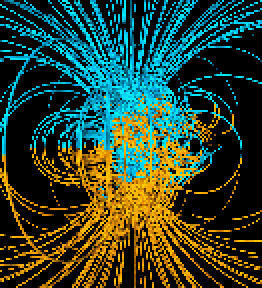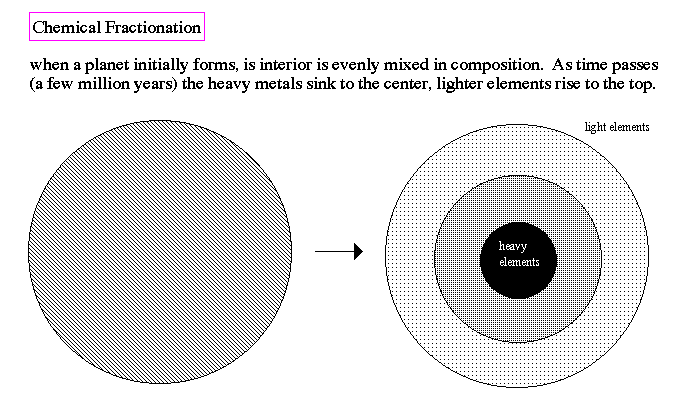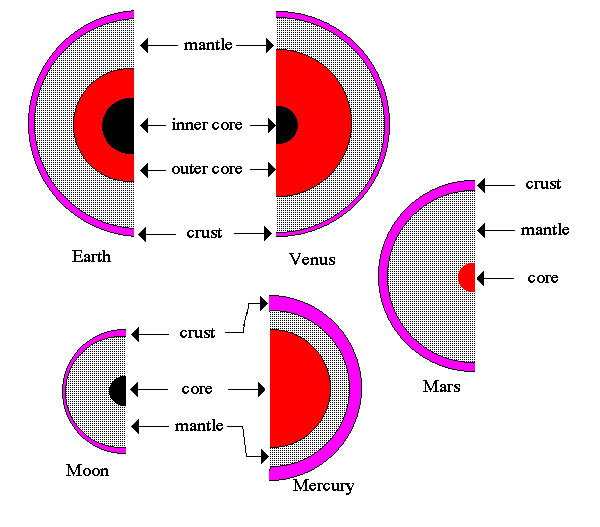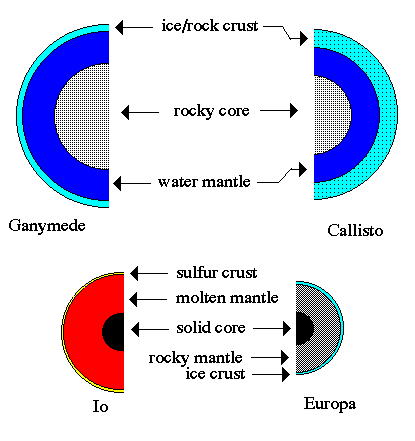Dynamo effect:
 A planet's magnetic field also provides a peek into its interior. For planetary
magnetic fields are generated deep in the core of the world. Our understanding of
the origin to magnetic fields in planets is very poor. We know that the Earth's
magnetic field is not due to the presence of a giant permanent magnet, such as iron,
deep in the Earth's core because 1) the core temperature is above the Curie temperature and 2)
the field is too variable. It must be a generated field and we know that a
conducting fluid in motion generates a
dipole magnetic field. The nature of this field and its evolution is governed by
the field known as magnetohydrodynamics. The liquid outer core of the Earth is the
conducting fluid, free electrons being released from metals, such as Fe (iron) and Ni
(nickel), by friction and heat. Variations in the global magnetic field represent
changes in fluid flow in the core.
A planet's magnetic field also provides a peek into its interior. For planetary
magnetic fields are generated deep in the core of the world. Our understanding of
the origin to magnetic fields in planets is very poor. We know that the Earth's
magnetic field is not due to the presence of a giant permanent magnet, such as iron,
deep in the Earth's core because 1) the core temperature is above the Curie temperature and 2)
the field is too variable. It must be a generated field and we know that a
conducting fluid in motion generates a
dipole magnetic field. The nature of this field and its evolution is governed by
the field known as magnetohydrodynamics. The liquid outer core of the Earth is the
conducting fluid, free electrons being released from metals, such as Fe (iron) and Ni
(nickel), by friction and heat. Variations in the global magnetic field represent
changes in fluid flow in the core.
The field of paleomagnetism examines the behavior of the Earth's magnetic field with time. Whenever a rock crystallizes from molten lava on the surface, the magnetic elements in the rock act like tiny compass needles and are frozen into position aligned with the direction of Earth's field. Fossil evidence for field reversals on timescales of 100,000 years indicates that the process of magnetic field generation is unstable.
For the planets it is key to know that a magnetic field indicates that:
1) the planet has a large, liquid core
2) the planet has a core rich in metals (source of free electrons)
3) the planet has a high rotation rate
The strength of the magnetic field is telling you something about the combination of the above factors. For example, Mercury has a weak magnetic field. But, since it has a very low rotation rate we conclude that it has a large liquid core. Mars has a high rotation rate (similar to Earth's), but a magnetic field that is 1/800th the strength of the Earth's. Therefore, we conclude that Mars has a very small core.
Chemical Fractionation:
The most important process early in the formation of a planet that influences its structure of its interior is gravity. Gravity causes heavier elements to sink to the core of a planet, this is called chemical fractionation.

Since this is a slow process, the planet may solidify before chemical fractionation can fully develop. Thus, large, massive planets, like the Earth and Venus, are molten long enough for a Fe and Ni core to form. Whereas, smaller planets, like Mars, cool faster and solidify before the heavier elements sink to the core. Thus, elements like Fe are over abundant in the soil, giving Mars its red color.
Crust development:
The thickness of a planet's crust is directly proportional to the rate at which the planet cooled in the distant past. A fast cooling rate (i.e. a small planet) will result in a thick crust. For the major terrestrial worlds, the crust thickness is proportion to the diameter of the planet is:

Note that the cooling rate is proportional to the total mass of the planet. Large worlds cool slower, have thinner crusts. High cooling rates also determine the interior structure. Slow cooling rates imply planets that still have warm interiors now. Warmer interiors imply more diversified structure (inner core, outer core, semi-solid mantle, etc.)
Note also that a thicker crust means less tectonic activity.
Summary of Terrestrial Planet Interiors:
The make-up of planet interiors is dominated by the physics of materials under high temperatures and pressures. Starting with cold, low pressure regions, rocky materials are straight solids. As one goes deeper into a planet the temperature and pressures go up. Solids become semi-solid, plastic-like materials. With higher temperatures and pressures, semi-solids become liquids. With even higher temperatures and pressures liquid or molten rocky materials undergo a phase change and become solids again. That is why the very inner cores of the Earth and Venus are solid, surrounded by liquid outer cores.




